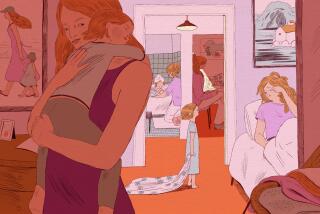‘90s FAMILY : Secret Life of Kids : Children delight in candy stashes and hide-outs--the things only they know. A problem? Not at all.
- Share via
Even now, seven years since she last dipped her toes into the forbidden midnight water, Dawna McVicker has not told her parents about her little secret jaunts.
On summer evenings as her parents slept, McVicker sneaked out of the family beach house to rendezvous with the sand, the moon and the waves. The first time she was 8--naive enough to think it a lark, but wise enough to keep it to herself.
“I would just sit there. I’d sing. I was never afraid of (the dark). It felt free. Completely free,” says McVicker, 24. “I remember sitting there. The moon was so bright and small. And the clouds would just roll in. And I’d listen to the waves. It sounded so rad. If I close my eyes now, I can see it.”
Good sense eventually ended the secret walks, but not the secret of them. McVicker, of Huntington Beach, says they still feel like her thing. Her secret child world.
Children love and harbor their secrets. They are the stuff of hide-outs, candy stashes, clubs, imaginary play, rituals and crayon drawings stowed with the socks in the bottom dresser drawer. They are removed from the adult world. That’s a particularly delicious ingredient, as anyone who has ever slipped beneath the sheets with a flashlight to read “The Secret Garden” or “The Boxcar Children” well knows.
And children need them. Secrets are generally a normal and healthy part of growing up, says JoAnne Pedro-Carroll, associate professor of psychology and psychiatry with the Primary Mental Health Project at the University of Rochester.
“Those benign kinds of secrets reflect a child’s need for autonomy,” Pedro-Carroll says. “It’s, ‘You don’t know everything about me, parents. This is something I can set up for myself.’ ”
Of course, that carries risks. Every parent wants to uncover sneaky forays to dangerous places or know where their teen-agers really are at night. And abused children can bury horrible secrets in an emotional underground.
Not everything unsaid is a secret. It may just be that no one’s asking children the right questions. Anne Soderman, a professor of Family and Child Ecology at Michigan State University, says she believes that happens too much.
“They experience things and they don’t quite know what to make of them,” Soderman says. “We don’t do very much sitting and talking with children.”
But childhood’s gentle secrets are definitely worth keeping, Pedro-Carroll says.
“It’s important to step back and give them their room, their space to have those separate times,” she says.
Stepping back is hardly the problem, many parents say. It’s not that they’re blind to their children’s secret lives. But catching a glimpse can be like watching for a comet that whizzes by once in a lifetime.
Ask Rebecca Lascoe’s 4-year-old daughter what she and her pal are doing in her mother’s bedroom, and she’ll describe a beautiful garden built for a wedding. But if Lascoe stands and watches, she’ll be treated like the uninvited guest that she is.
“Usually they’ll just kind of stop everything and just look at me, like, ‘You’re bothering us,’ ” says Lascoe, of Studio City.
Glen Constantino knows his three children have an adventurous and probably grubby world unto themselves in the wooded enclave of their Silver Lake home and the nearby lake. On occasion he gets a peek.
“They have secret hiding places for candy by the lake,” he says. “That is their secret stash.”
When they revealed it, he squelched a grimace but offered one thought.
“Do you guys really think this is going to be any good?” he asked.
Constantino says he believes his children’s world is a healthy, creative outlet that adult trespassing would soil.
“I’d rather not know what they’re up to,” he says.
A 6-year-old is glad his parents don’t know what he’s up to in the dirt of Adventure Playground in Irvine. In a city where planning and orderliness are nearly sacred arts, this playground is a haven--albeit a planned and supervised one--of muddy, messy and unstructured play.
Under one of the handmade forts that are the park’s hallmark, he reveals his secret place to hide and eat candy. It’s two tires wedged together to form a cozy seat, a 6-year-old’s version of a La-Z-Boy. He swears he falls asleep here.
“Shhhhh!!!” he tells a visitor who marvels a bit too loudly. “They’ll find out it’s here.”
But his best secret, the reason you won’t see his name here, is the big rope swing. His mother says it’s off-limits. Too dangerous. He thinks it’s glorious.
“Seeeee? Whaaahooooo!” he shouts as he pushes off from the tree trunk, his feet hooked around a knot as he swings in a wide arc. And what does he tell his parents after a day at Adventure Playground?
“I just tell them I had fun,” he says.
Secretive? A little deceptive, even? Yes and no, Pedro-Carroll says. Children, all people for that matter, enjoy controlling a private corner or two of their lives. But children can seem secretive because they don’t quite know how to share and understand feelings.
In the preschool years, imaginary friends, self-conversations and pretend play help out. Later, intense and frequent play with one best buddy, diaries and art often fill in. “Drawing and playing for children are ways that they work out their feelings,” Pedro-Carroll says. “They can’t always tell us in words and sometimes they don’t always know exactly themselves how to put feelings into words. Fantasies and secrets feel safer.”
The drawings in Amanda Benavidez’s bottom drawer might have been secret forever if not for the fate of clean laundry. She was working on her drawings when Diana Benavidez whisked into her room with folded clothes. Benavidez is still surprised by the art she found. Amanda, 8, had filled several pages with drawings of houses. Each was an example of a house Amanda hoped they could have someday. As a military family, they have moved nine tines in 10 years.
“She said they were the houses she would like if they ever let us stay someplace long enough to buy a house,” says Benavidez, whose husband is a pilot stationed at El Toro Marine Corps Air Station.
The added surprise was that each blueprint included a trophy room for Amanda’s T-ball trophies. All three of them.
“They’ve been damaged in the moves. The screws are wobbly. I guess that’s frustrating to her. I didn’t realize how important they were to her. She has only three, but that is like her pride and joy,” Benavidez says.
The luck of the incident was that Amanda got to talk a little about how she felt and her parents had a chance to hear it.
A secret worth sharing.


